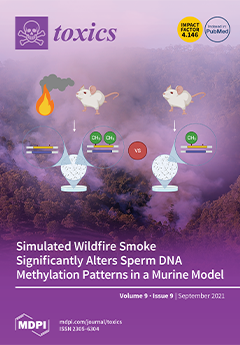The phthalate and semi-volatile organic compounds (SVOCs) are modern chemical substances and extensively existing in the indoor environment. The European Commission stipulated the “European Unified Test Criteria”, since 2011, for the declared specifications of building products (CEN/TS 16516), based on the “lowest concentrations
[...] Read more.
The phthalate and semi-volatile organic compounds (SVOCs) are modern chemical substances and extensively existing in the indoor environment. The European Commission stipulated the “European Unified Test Criteria”, since 2011, for the declared specifications of building products (CEN/TS 16516), based on the “lowest concentrations of interest (LCI)”, the index pollutants, test method, and emission standard of “phthalate” and “SVOC” were specified in detail. The purpose of this study is to use six common indoor floor construction products in Taiwan (regenerated pseudoplastic rubber flooring, healthy pseudoplastic imitation wood floor, regenerated pseudoplastic rubber flooring, PVC floor tile/floor, plastic click floor, composite floor covered with carpet) to detect the changes in the concentration of phthalate emitted to the air. The ISO 16000-25 Indoor air—Part 25: Determination of the emission of semi-volatile organic compounds by building products—micro-chamber method is used to build a DS-BMEMC (glass micro-chamber: volume 630 mL), the SVOC, including phthalate, is collected in two stages, in the stable conditions of temperature 25 °C, relative humidity 50% and air change rate 2 times/h, the Stage 1 emission detection experiment (24 h) is performed, and then the Stage 2 heating-up desorption emission detection experiment (40 min air sampling) is performed, the temperature rises to 200–220 °C, the phthalate and SVOC adsorbed on the glass micro-chamber is desorbed at a high temperature to catch the air substances, the air is caught by Tenax
®—TA and Florisil
® adsorption tube, and then the GC/MS and LC/MSMS analysis methods are used for qualitative and emission concentration analyses of SVOC of two-stage emission, respectively. The findings show that the floor construction materials emit nine phthalate SVOCs: DEHP, DINP, DNOP, DIDP, BBP, DBP, DIBP, DEP, and DMP, the two-stage emission concentrations are different, Stage 1 (normal temperature) emission concentration of six floor construction materials is 0.01–1.2% of Stage 2 (high temperature) emission concentration, meaning the phthalate SVOC of floor construction materials is unlikely to be volatilized or emitted at normal temperature. An interesting finding is that only S3 was detected DINP 72.6 (μg/m
3) in stage 1. Others were detected DINP in stage 2. This might be because S3 has carpet on the surface. This implies that floor material with carpet may have an emission of DINP at normal temperature. The result of this study refers to the limited value evaluation of EU structural material standard emission TSVOC ≤ 0.1 ug/m
3, the floor building material emissions are much higher than the evaluation criteria, increasing the health risk of users. The detection method and baseline can be used as the standard for controlling the emission of phthalate SVOC of Taiwan’s green building material labeling system in the future.
Full article






